

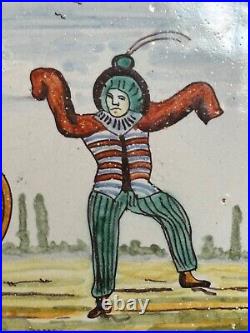
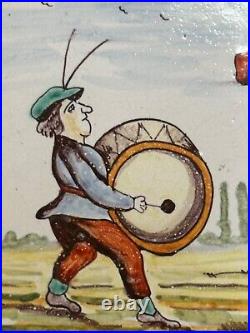

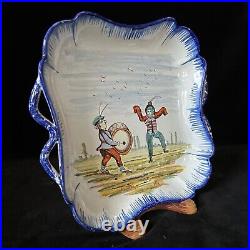

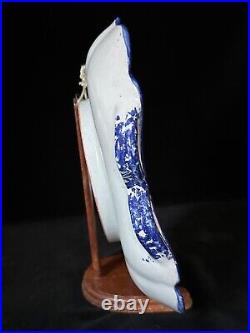

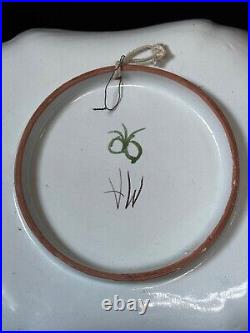
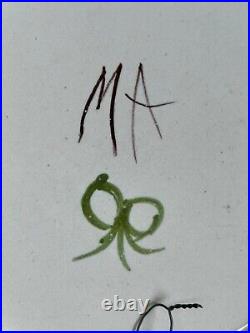

MONTAGNON SQUARE SCALLOPED PLATE DRUMMER & DANCER. Nevers French Faience c1895 #4. This is a very rare and unusual antique Nevers French Faience. The subject matter on the SQUARE SCALLOPED PLATE includes a décor of two well-dressed men each in colloquial period garb, including a jacket, vest, patterned pants, stylish hats, and clogs. One is marching and plays a bass drum; the other is dancing with arms up in the air. They are amidst a scenic decorative landscape of a field with birds flying overhead. The SQUARE SCALLOPED PLATE has modeling, decorating, and glaze that are exceptionally well done with typical colors of antique Nevers pottery: creamy white background decorated with varying shades of blue, yellow, green, orange, brown, lilac, and magenta. The border edge is formed and scalloped, has a stylized border, with a dark blue rim edge. There are double handles on either side; this form of this plate is a vegetable serving dish. The underside bottom is glazed; the raised rim foot is unglazed; there is a small, pierced hole with an attached a wall-hanger. The underside bottom has a makers’ mark: a large green ribbon bow in green glaze, stylized A. In magenta (the mark of Montagnon, 1875- 1899), marks of old and original French Art Pottery. Dimensions: 2.0 in. Tall X 10.0 in. Wide X 9.2 in. Horizontal: 11.0 in. The estimated date is circa 1895. This French antique is in very good condition, noting minor fretting on top rim (see photos). Condition status includes minimal normal wear and rubbing, glaze losses, firing flaws, crazing, and fretting. This item is sound, having no chips, cracks, or major defects, and having had no apparent repairs or restorations. Please see all photos which are a part of this description. Please note that this item is photographed in natural light; shadows that may appear as irregularities are not necessarily chips, cracks, or discoloration. Please note this faience item is from Nevers faience. Not Quimper or Desvres. Though similar, there are different color palettes used and other nuances on the two potteries. Nevers faience manufacture was from central France in the area of the same name. The area was famous for superb art pottery known as faience; a pottery technique whereby tin glazes and decorations are applied over a modeled terra cotta or clay forms, and fired several times in a kiln. The city of Nevers, Nièvre, now in the Bourgogne-Franche-Comté region in central France, was a center for manufacturing faience, or tin-glazed earthenware pottery, between around 1580 and the early 19th century. Production then gradually died down to a single factory, before a revival in the 1880s. Nevers faience was one of the centers where the istoriato style of Italian maiolica was transplanted in the 16th century, and flourished for rather longer than in Italy itself. In the 17th century Nevers was then a pioneer in imitating Asian ceramic styles in Europe, within some decades followed by all producers of fine wares. The second half of the 17th century was Nevers’ finest period, with several styles being made at the same time, including a grandiose Italianate Court style. By the time of the French Revolution Nevers wares had ceased to be fashionable and expensive, but the relatively crudely painted faience patriotique wares commenting on political events have great interest and charm. A late 19th-century revival concentrated on high-quality revivalist wares recreating past glories. In 1838, 700 workers were reported to be employed, but by 1846 only six factories remained, and by 1850 five. By 1875 its fortunes had reached a low ebb, and it was bought by Antoine Montagnon, who had ambitious plans to relaunch it to supply the market for revivalist wares imitating 17th-century pieces, often large and complex pieces. By 1881 it was the only factory left in Nevers. The Montagnon factory (faïencerie) was successful for over a century, with 50 employees around 1900, and its wares exhibited at international exhibitions, but the factory, by then the oldest in France, finally closed in 2015. In 2020, two factories remained in production, both mainly making traditional styles. Please check out my other listings with Fleurman. Please bookmark this work; Listing Category and List Price are subject to change. If you see something wrong in a listing, please send me a message and let me know and I will address the situation accordingly.

